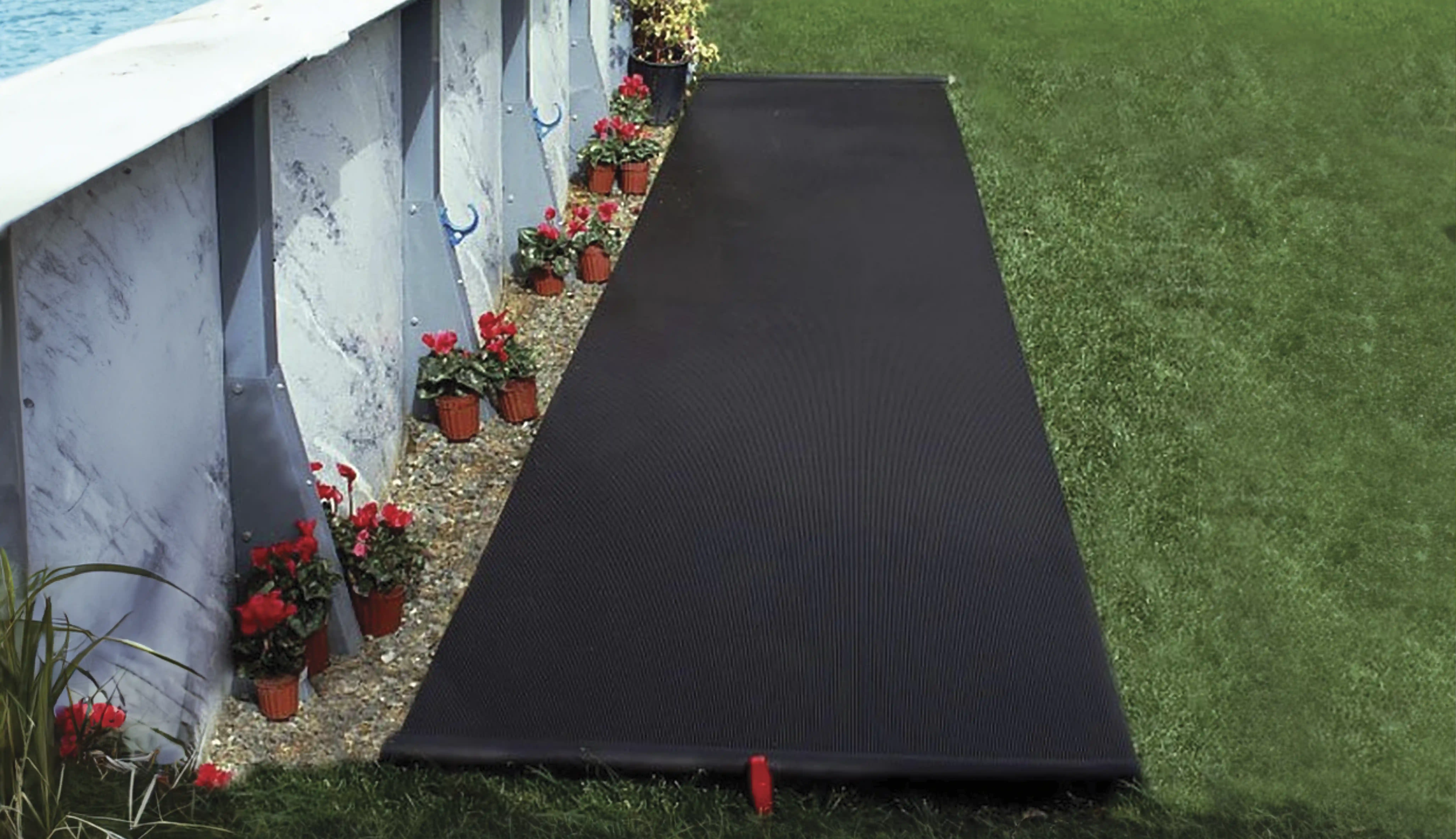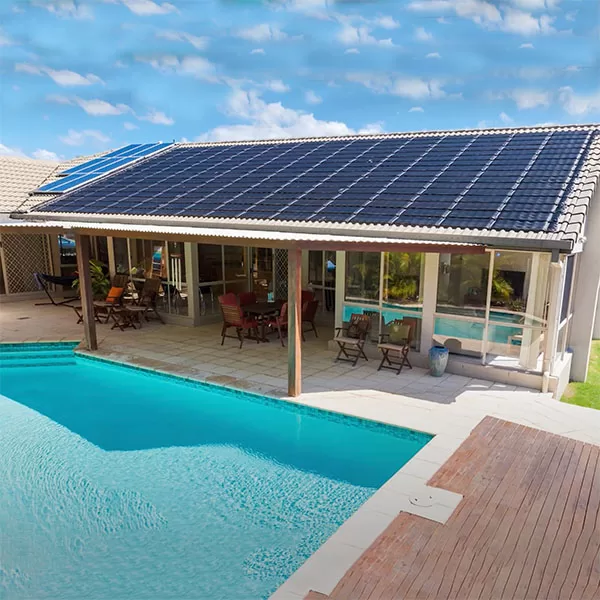FREE Standard Shipping On All Orders $100 or More!*

Install a Solar Pool Heater This Weekend
From simple, single ground panels to multi-panel roof mounted systems, we'll go over the different types of solar pool heaters, and show you how to install them in a weekend.
What Are Solar Pool Heaters and How Do They Work?

Solar pool heater panels are constructed of rows of small, hollow tubes made of black polypropylene (super strong plastic) or rubber that are seamed together to create a large surface area called a panel. The sunshine heats the black mat, and as water passes through, the heat is transferred to the water and returned to the pool. Solar panels are an eco-friendly way to heat your pool by 10–20°F, with do-it-yourself installation, zero emissions, and zero operational costs.
Solar heaters come in a variety of shapes and sizes but the mechanics are basically the same. You can use your existing pump to circulate water through black tubing which naturally absorbs heat from the sun and sends that heated water back to your pool.
The more surface area the solar heater has, the more BTU’s of heat are generated. And the more BTU’s you generate, the greater the volume of water you can heat. Since a pool is open to the air, heat can be lost quickly. To combat the heat loss, it is recommended to over-size a solar pool heater.
One or more panels can be joined to create more surface area. Panels can be installed for above ground and in ground pools, positioned in a variety of ways, and controlled manually by turning a valve or automatically, with a solar controller.
Above Ground Solar Pool Heaters
Small Pools:
If you own one of the ever-popular soft-sided pools, like the pop-up or metal frame pools from makers like Intex, there are some quality do-it-yourself solar heaters that are simple to install and take up very little yard space.
By coiling black tubing and covering it with a convex dome, the SunCoil solar heaters can be plumbed into your filter system by simply adding one more hose section after your existing pool pump & filter.
To install, all you need to do is turn off your pump and isolate your system by blocking off your skimmer and return or closing your shut-off valves. Next, disconnect the hose to the return and plumb it to the solar heater intake, then add another hose, fitting, and clamp from the solar heater output to the return fitting on the pool wall. Unblock your skimmer and return, and turn the system back on, and you are ready to enjoy the free heat!
The SunCoil solar heater sits on the ground and can be tipped on 2 legs to maximize the best angle to the sun. A by-pass valve kit is included to shut-off the solar system during night or rainy days. The bypass kit also slows the water flow to allow the solar panel to maintain optimum heating temperature.
Large Pools:
For larger, steel-sided above ground pools, there are a variety of manufacturers of much larger solar panels. These are long and flat, rigid yet bendable, and typically 2’W x 20’L or 4’W x 20’L - so you will need a long space to put them. Oval above ground pools lend themselves well to these systems, as you can place them along the length of the pool, on a small rack attached to the braces or kickers. For round pools, you need to be a bit more creative.
The panels can be laid flat on the ground, mounted to a fence, or you can build your own solar panel rack from angle iron, 2 x 4’s, PVC, or other frame materials. Over top of this triangular frame, attach plywood and mount your solar panels.
For above ground solar pool heaters, you can connect these panels the same way as the compact ones by adding just one hose, fitting, and hose clamp. The panels connect after your pump and filter, and feed into your return line. If you want to locate them farther away from the filter, you simply need a longer hose or pipe.
If you are linking multiple panels, beware that some brands of above ground panels are split in the middle so water goes down and back in every panel so look for the stickers to identify the inlet and outlet. As you add more panels you will want to line these up so the water flows in, back and forth, and then out.
Above Ground Pool Solar Panel Installation:
There are two types of solar systems for above ground pools — the SunCoil Solar Dome, and the EcoSaver solar panels. Both are extremely simple to install; you can set up your own above ground solar panels in under an hour.
Shut off the pump and plug the skimmer and return line in your pool to stop water flow.
- Choose the location for the panel(s), where they will receive at least 6 hrs of sun per day. A southern-facing direction, unobscured by trees is best. SunCoil heaters should not be roof mounted, but the EcoSaver panels can be installed on a roof top (see below).
- The Universal Solar pool panels can be installed flat on the ground, but if you can build a small rack from wood, to mount them at an angle, your solar panel(s) will absorb more sunlight.
- Connect the return hose from your pump into the solar panel inlet, to bring the cold water into the solar heater.
- Connect the return hose from the solar panel outlet to the pool wall return, to bring the warm water into your pool.
Both solar systems are modular, letting you connect additional panels to each other. They can even be installed in different locations, or you can pipe your water to a remote location. Panels are most effective if they are angled 35°–45° to the sun for maximum heat collection. Just use a few straps or clips to secure them to a solar panel rack. Again, a by-pass system is recommended for these panels, so you can dial in the flow rate or send the water around the solar panels at night or on a cloudy or rainy day.
Inground Pool Solar Heaters

There are solar panel kits available for in ground pools in many sizes; 4’W X 10’L or 4’W X 20’L. A good rule of thumb is to have roughly half of your pool’s surface area equal in panel square feet. Inground pools typically have much stronger pumps, so the panels can be mounted on a nearby roof, even 2 stories high. A garage or pool house roof or side of a hill is a good place, or you might consider building an A-frame from treated lumber and plywood near the pump and filter area.
Installation kits include roof mounting straps and hardware to secure them. All you need is a drill, caulk, and a helper to hold them in place while you work. Mark where your straps will go. You will want one on each end and then space out the rest equally. Drill into the roof or plywood on each side of the panels through the strap, caulk, and screw in the lag bolt or securing hardware (manufacturers have different hardware kits, but drilling is the same - although you may not always have to drill through the strap). You want the straps to overlap each panel and hold it down. Keep the holes a few inches away from the panel edges. Insert connecting fittings and caps between the panels, and connect panels one by one.
Inground Pool Solar Panel Installation:
Inground base panel kits include fittings and check valves to keep the panels primed so when the pump turns on and off the water easily flows without air traps and without having to re-prime the panels each time. Installing an inground solar pool heater will take more time than the above ground units, because you need to do a little plumbing, and you will have more panels to connect together.
You can build a rack somewhere in the yard, or even on the back of your fence. It need not be next to the pool pump, although the further away from the pump, the more you will spend on plumbing pipes running to and from the panels. Perhaps a patio gazebo, providing a shady spot for relaxation and an out of the way location to mount your solar panels.
- Unbox your panels and connect them together. Panels have separations to allow you to wrap around roof vents.
- Secure the panels to the roof with the included hardware. Attach the cross straps to hold down panels in high winds.
- Cut the return pipe after the filter, and glue on a one-way check valve and the 3-way diverter valve, included in the Solar Controller package.
- Connect another pipe on the opposite corner of your solar panel array. Run this exit pipe parallel to the top of the panels.
- Run the exit pipe off of the roof or rack towards the return line that was cut in step 3.
- Before connecting the exit back into the return line, glue on a one-way check valve, to prevent water from entering the panels in the opposite direction.
- After the check valve, connect the exit pipe back into the return line.
Solar Pool Heater Panel Connections
Depending on the brand, the connections can vary, but when you buy a kit of 2 or more panels they will include the plumbing and hardware to connect the panels. Smart Pool solar panels have 1.5” threaded female openings on either end which you can attach a 1.5” male thread, while Fafco panels have barbed ends that protrude out at each “corner” or end that are sized for radiator hose and standard stainless hose clamps.
If you are installing on a rooftop, be sure to pick up enough fittings to make the transition over the eave of the roof, and down to the ground and some pipe straps to secure the plumbing run to the roof and wall. For masonry walls, use tap-con screws to secure the pipe clamps
From there you can find the appropriate connector pieces for your PVC, flex, or above ground pump & filter hose at your local hardware store.
Connect the line gong to the panels to a bypass valve after your filter for the water supply and tie the bypass line and returning solar heated water line into your return line with a tee fitting. Now you can turn on the pump, open up the by-pass valve and send the water to the solar panels.
Solar Controller Installation:
A Solar Controller allows you to set a temperature dial, and includes temperature sensors, a 3-way Valve and Valve Actuator (automatic valve turner), to send water up to the solar panels only when conditions are optimum for gaining solar heat. When heavy clouds pass, rain begins to fall or at dusk each night, the actuator will turn again, bypassing the solar panels. For best results with an inground solar pool heating system, I highly recommend installing the optional Solar Controller.
- Mount the Solar Controller box on the wall or a sturdy post.
- Connect the power by plugging the cord into a grounded outlet.
- Drill a hole into the pipe before the 3-way valve, insert the water temperature sensor and clamp it to the pipe.
- Clamp or silicone the second sensor next to the solar panels, to monitor the panel temperature.
- Connect the wires from both sensors into the solar controller box.
- Remove the handle from the 3-way valve, to mount the actuator onto the valve.
- Connect the wire from the valve actuator into the solar controller box.
- Set the temperature dial and test the system.
Solar Pool Heater Automation – Set it, and Forget it!
You can automate your solar pool heater by installing a wall mounted controller, valve actuator, and a water and air temperature sensor. Some popular models are Hayward’s Goldline Solar Controller and Pentair’s Sun Touch.

Solar controllers allow you to set your desired temperature. The sensors measure the air and water temperature. If the air temperature is greater than the water temperature, it tells the valve actuator to open the valve and send water to the panels to raise the water temperature. Likewise, if a hot sun is not available, the controller closes the valve so you don’t cool the pool down.
Controllers may also feature freeze protection and circulate water in the event that it is cold enough to freeze in the panels and potentially damage them.
Some controllers are also designed to control other features of your pool or spa like their pumps, heaters, lighting, etc. so you can automate when they turn on or off. Controllers can control valves to switch from solar panels to a gas heater or electric heat pump so you only use those when you have to - which maximizes your energy consumption and saves you money!
Solar Pool Heating FAQ:

Q: Will I need to upsize my pool pump to push water up to the roof?
A: As long as you have a 1 hp pump or greater, you should have no problem, even pushing the water up 2 stories. You will notice that the filter pressure will rise 2-4 lbs on the pressure gauge, but most pumps can handle the extra resistance without a problem.
Q: I have a pressure-side pool cleaner, will this conflict with it's operation?
A: If you have a booster pump type pool cleaner, it is recommended that you not operate it at the same time as the solar pool heater. The Solar Controller has a booster pump override to shut off the booster pump when the valve actuator opens to send water to the solar panels.
Q: Can I mount the solar panels on 2 different sides of the roof?
A: Yes, after exiting the first panel set, run a pipe to the second panel set, and so on, then back down to connect to the return line.
Q: Do I need to install the Solar Controller?
A: It is recommended for best results. If it starts to rain, or heavy clouds form, sending water to the solar panels will cool the water, and reverse the heat gains made earlier.
Q: What about winterizing my solar panels?
A: Solar panels are installed with a slight pitch toward the exit pipe, with an air-lock valve on the opposite corner, to allow complete drain down during fall closing. If pitched correctly, there should be no need to "blow-out" the panels with air, although you can easily do this if you wish.
Once you have your solar pool heater set up, you start producing free heat from the sun without any impact on the environment and you will be swimming before your neighbors and long after they have closed their unheated pool!